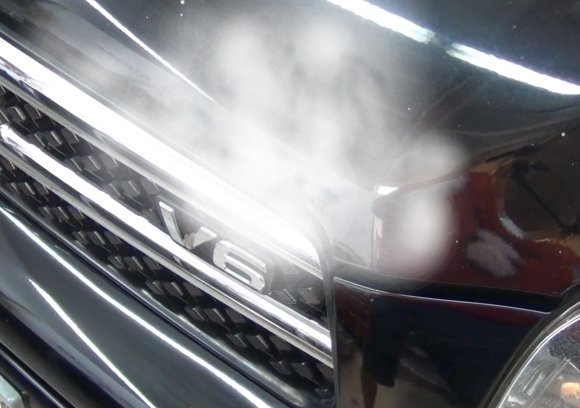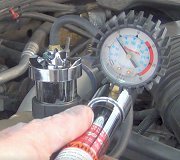Tune-ups do not solve coolant loss or white exhaust smoke. When that smoke is constant, it is almost always caused by a leaking cylinder head gasket. You'd be losing coolant on a regular basis too, with no visible leak or puddle. While it is always a possibility, coolant leaking into the engine oil is by far the least common way for a cylinder head gasket to fail. Most mechanics will never run into that.
Depending on how bad that smoke is, if it only happens once in a while, a better suspect is condensation in the muffler due to excessive short-trip driving. One of the byproducts of a properly-working catalytic converter is water vapor. That normally burns off when the muffler gets hot enough. Another common observation with short-trips is a white, milky-looking substance under the oil cap. Air is drawn through the lower end of the engine to draw out blow-by, and that air has humidity in it. That condenses inside when the engine is cold, and the engine needs to be up to full operating temperature for a long time to vaporize that water so it too can be drawn out. The clue to this is there will often be droplets of water on the bottom of the oil cap, and those will be clear, not the green or red color of your coolant.
You found coolant leaking from the radiator and a hose. The only proper solution is to replace those parts. Radiators and heater cores corrode when the coolant is not replaced every two years. The antifreeze will always be antifreeze, but it's the additives that wear out in two years. Those include corrosion inhibitors, seal conditioners, water pump lubricant, and anti-foaming agents. Some other manufacturers have much worse trouble with this. Acids normally form in the coolant. When you have two different metals and an acid, you have the same "galvanic action" that takes place in a battery, and that is what leads to the corrosion. Cooling systems have brass, lead, tin, iron, and aluminum, so those coolant additives have to be replenished periodically.
No "mechanic-in-a-can" is going to solve the leaks you found. Rubber hoses flex a lot, so any patch is going to tear apart as the hole becomes bigger. The radiator hoses and heater hoses rot from the inside, so you won't see a problem until the first one pops a leak. If that's in the middle of a hose, it usually lets go without warning and lets you sit on the side of the road. When it's near the end, it is often due to a loose hose clamp. Those can fall apart due to rust, or the rubber hose under the clamp can be deteriorating. When a hose is leaking or is found to be soft and mushy, a conscientious mechanic who has your best interest at heart will strongly recommend replacing all the hoses at the same time.
There have been some successful leak-stop additives in the past, but they work in one of two ways. One is simply large chunks about the size of pepper flakes. Those plug small holes when they try to flow through them. They can also plug small passages or the small bleed hole in some thermostats. The tubes in heater cores are very narrow to allow for better heat transfer to the air flowing past them. Those are real easy to plug even before adding these kinds of leak-stop additives.
The other kind of additive coagulates where it leaks out and comes in contact with air. When the engine warms up, the coolant expands into the reservoir, which is partially-filled with air. Once the product turns to gel and gets sucked back into the system, it can plug radiator tubes and heater core tubes just as easily as it plugs small leaks.
The other problem with leak-stop additives is even when they do work, they are only meant to be a temporary fix until the proper repairs can be made. When a radiator tank corrodes through, remember that all the rest of that tank has been corroding away at the same rate. The point of the leak is just the first place that occurred. When one leak is plugged, pressure can build up again in the system, like it is supposed to, then it's just a matter of time before the next point pops a leak. I tried soldering holes in the radiator of one of my older vehicles. That worked every time, and the system held pressure after each repair. I had to pull that radiator out, solder a hole, reinstall it, and refill it seven times in three weeks before I finally gave up.
The lower radiator hose attaches to a cast-in tube that is part of the water pump housing. That hose clamp could be loose too, but that's right next to the weep hole under the water pump's shaft. You'll usually need a small mirror to peek under there. If you see wetness by that hole, the seal in the water pump is leaking, so the pump will need to be replaced. That leakage can be slow enough and intermittent so as to cause the coolant to dry up there, but it will leave the telltale stain behind.
Once you're replaced everything with known leaks, if you're still losing coolant, but too slowly see where it's originating from, you can add a small bottle of dark purple dye to the coolant, then check a day or two later with a black light. The dye will show up as a bright yellow stain that you can follow back to the source. This works well for leaking head gaskets too. If one is leaking, you'll find the dye inside the tail pipe. Auto parts stores have the correct dye for the fluid being tested, and those that rent or borrow tools should have a black light.
Here's links to some articles that you might find useful:
https://www.2carpros.com/articles/car-is-leaking-coolant
https://www.2carpros.com/articles/coolant-flush-and-refill-all-cars
https://www.2carpros.com/articles/replace-radiator-hoses
https://www.2carpros.com/articles/how-to-replace-a-car-radiator
https://www.2carpros.com/articles/symptoms-of-a-bad-water-pump
https://www.2carpros.com/articles/water-pump-replacement
Thursday, May 13th, 2021 AT 12:16 PM


